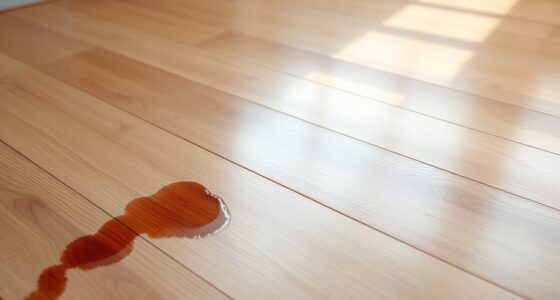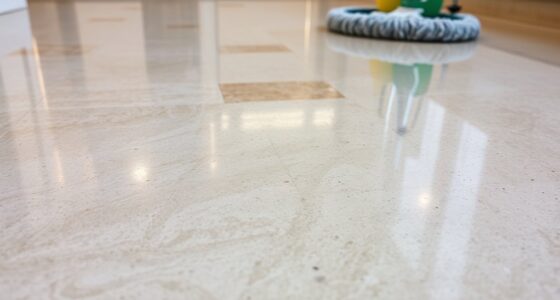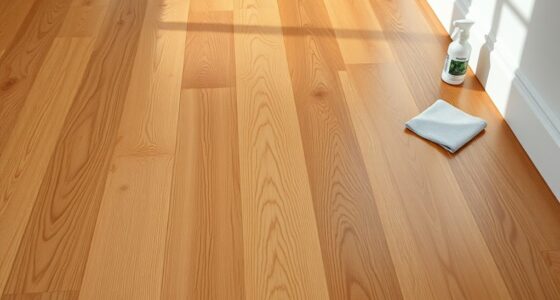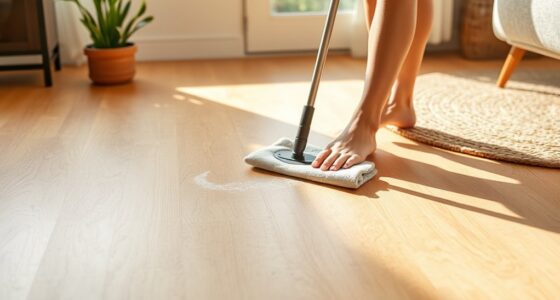To keep dust from engineered wood safe, use air filtration systems with HEPA filters and regularly clean surfaces with damp cloths or microfiber mops. Vacuum with HEPA-equipped sweepers and avoid sweeping to prevent stirring dust into the air. Wear protective masks during work and set up a well-ventilated workspace. Maintaining these routines helps reduce airborne particles and keeps your environment healthy—continue ahead to discover more effective dust control strategies.
Key Takeaways
- Use HEPA-filtered air purifiers and proper ventilation to trap airborne dust particles from engineered wood.
- Employ HEPA-equipped vacuum cleaners and damp cleaning methods to minimize dust resettling on surfaces.
- Designate specific work areas with local exhaust systems to contain dust during cutting and sanding.
- Regularly inspect and maintain filtration units, and wear personal protective equipment like HEPA masks.
- Seal dust collection bags securely and clean all surfaces thoroughly after work to prevent dust accumulation.

Dust control is essential when working with engineered wood to guarantee a safe and clean environment. When you’re cutting, sanding, or installing engineered wood, tiny particles become airborne, posing health risks and creating a messy workspace. To keep dust levels in check, implementing effective air filtration and cleaning techniques is crucial. Good air filtration systems help trap airborne dust particles before they settle on surfaces or enter your respiratory system. Using HEPA filters in your ventilation or portable air purifiers ensures that even the smallest particles are captured, significantly reducing airborne dust. Make sure your filtration units are appropriately rated for the size of your workspace, and keep filters clean and replaced regularly to maintain efficiency.
In addition to air filtration, adopting proper cleaning techniques is vital. Frequent dust removal prevents accumulation that can become airborne again. Use a vacuum equipped with a HEPA filter to pick up dust from floors, workbenches, and equipment. Avoid sweeping, as it often stirs up dust into the air, creating a health hazard. Instead, opt for damp mops or microfiber cloths to trap dust particles on surfaces. When cleaning tools or equipment, handle dust carefully by sealing collection bags or containers to prevent dust from escaping into the air. Staying vigilant with these cleaning methods reduces the overall dust burden and minimizes exposure.
You should also create a routine that incorporates these air filtration and cleaning practices into your daily workflow. Set up designated areas for cutting and sanding engineered wood, ideally in well-ventilated spaces or with localized exhaust systems. Regularly check your air filtration units, ensuring they operate correctly. When working, wear appropriate personal protective equipment, such as masks with HEPA filters, to further limit inhalation of dust particles. After completing tasks, take time to thoroughly clean all surfaces and tools, focusing on areas where dust tends to settle. Incorporating HEPA filtration technology into your setup can greatly enhance dust removal efficiency and protect your health.
Frequently Asked Questions
Can Dust From Engineered Wood Cause Long-Term Respiratory Issues?
Yes, dust from engineered wood can cause long-term respiratory issues. Airborne fiber hazards, like formaldehyde and fine dust particles, can irritate your lungs over time. Health impact studies link prolonged exposure to these fibers with respiratory problems such as asthma and chronic bronchitis. To safeguard yourself, use proper dust control measures, wear masks, and ensure good ventilation, reducing your risk of long-term health issues.
What Are Eco-Friendly Dust Suppression Options for Engineered Wood?
Eco-friendly dust suppression options for engineered wood are like a breath of fresh inspiration. You can use natural additives such as cellulose or clay to trap dust effectively. Reuse techniques, like recycling sawdust for other projects, help reduce waste. These methods not only protect your health and the environment but also keep your workspace cleaner, making your dust control routine sustainable and safe for everyone involved.
How Often Should Air Filters Be Replaced During Dust Control?
You should replace your air filters every 30 to 60 days during dust control to guarantee ideal HVAC maintenance and filter longevity. Regularly changing filters helps trap airborne dust particles effectively, reducing allergy risks. If you notice reduced airflow or increased dust buildup, consider replacing filters sooner. Consistent maintenance not only improves indoor air quality but also prolongs your HVAC system’s lifespan, making your allergy-safe routine more effective.
Are There Specific Personal Protective Equipment Recommendations?
You should follow PPE guidelines closely to guarantee your safety. Wear protective gear like a dust mask or respirator rated for fine particles, safety goggles, and gloves when working with engineered wood dust. Make sure your respirator fits properly and replace filters regularly. Using appropriate PPE minimizes allergy risks and exposure, keeping you safe during dust control tasks. Always prioritize protective gear to maintain a safe and healthy environment.
Can Regular Cleaning Methods Effectively Reduce Dust Buildup?
Like a well-trained maid from the Victorian era, regular cleaning methods can effectively reduce dust buildup on engineered wood. You should use proper vacuum techniques, such as a HEPA filter-equipped vacuum, to pick up fine dust particles. Stick to a consistent cleaning schedule—daily or weekly—to keep dust levels low. This routine helps minimize allergies and maintains a healthier environment, making your space safer and more comfortable.
Conclusion
By following these dust control tips, you can create a safer, allergy-friendly environment on your engineered wood surfaces. Did you know that indoor dust particles can contain up to 80% allergens, including mold and pet dander? Regular cleaning and proper ventilation markedly reduce these risks. Taking proactive steps not only protects your health but also prolongs the life of your flooring. Stay consistent, stay safe, and enjoy a cleaner, healthier home every day.









